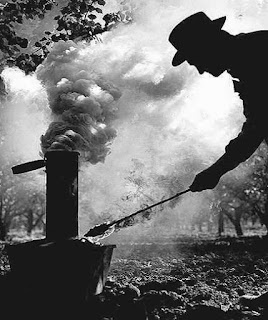Why I Model The Southern California
Citrus Industry
Why I model something this specific is rooted in my belief
that there is more satisfaction when a layout reflects a concise time period, a
well defined geographic area, a signature industry and the supporting elements
of all three. I don't advocate this approach for everyone but it serves me
well.
Personally there is not the need to achieve the near perfect
geographic accuracy some of the most dedicated layout owners have attained. And
I certainly applaud that. But after many years of learning and observing in the
hobby, I have reached a point where a whimsical layout with scenery, locomotives,
cars, industries and structures that are greatly mismatched and span a vast,
unrealistic timeframe, just is not satisfying for me.
My upstairs layout in Mission Viejo
was a concession to the substantial timeframe represented by the locomotives
and rolling stock I had acquired over many years. I tried to model the Santa Fe in 1956 and 1971 with some limited deference to Southern California, the citrus industry and a lot of
other things. After awhile it became apparent this layout lacked purpose and became
a bit boring.
The Upstairs Layout In Mission Viejo
So I looked for a concise layout concept that "held
together" well and could be modeled reasonably and effectively with
available rolling stock, structures and historical resources. There were many
choices, and for me that turned out to be the Southern
California citrus industry circa 1956.
I was deeply influenced by a presentation in 2004 at the NMRA
National Convention in Seattle.
Bill Messecar and Jim Lancaster gave a clinic on modeling the citrus industry. They
illustrated how a specific industry could give purpose and structure to a model
railroad and its operations potential.
This persuaded me to consider refocusing the purpose of my
then very generic Santa Fe
layout. As I concentrated on a theme a clear picture began to emerge of what I
wanted to accomplish. This was to be an era and geographically specific layout
based on a particular industry with the ability to conduct operations
reflecting all these elements.
 Bill Messecar
Bill Messecar
 Jim Lancaster
Jim Lancaster
By
early 2005 Bill and Jim’s inspiration led to the establishment of my Citrus
Industry Modeling Group on Yahoo (https://groups.yahoo.com/neo/groups/citrusmodeling/info). This obligated me to research the citrus
industry and its relationship with the railroads to generate content for the
website. This also benefitted my own needs. Group member helped to increase my
knowledge of the citrus industry and related railroad operations through their many
thoughtful contributions. I
found the history of the railroads and the citrus industry fascinating and very
engaging.
The available
HO scale rolling stock was plentiful as Intermountain, Tichy, Red Caboose and
CB&T Shops offered many different Santa
Fe and PFE ice bunker refrigerator cars. I took a deep
breath and decided to pay the high cost of better, more accurate freight cars.
I should add that swap meet purchases made this a less of a hit on my budget.
My
nearly forty-year acquisition program left me with many locomotives and cars
that were too "new" for my era. New homes were needed for these
items.

Intermountain Refrigerator Cars
Model Detailed By Michael Gross
There
were many, many period structures available and several sources for icing
platforms and packing houses. There were numerous books and magazine articles available
and Jim Lancaster had an excellent packing house website (http://coastdaylight.com/ljames1/scph.html).
There
were numerous articles on-line and photographs as well. The various local
libraries and historical societies also had plentiful resources.
As I
became immersed in the history of the citrus industry through those resources I
became more confident about scratch building infrastructure. Certainly there
was no shortage of examples for packing houses, juice plants, cold storage and
ice production plants, smudge oil facilities, tank houses, farm buildings and
citrus groves. Scratch building would allow me to fit appropriate structures
into available space either through selective compression or shallow relied
techniques.
Scratch Built Shallow Relief Packing House
Smudge Oil Unloading Facility
So
the motivation, hobby equipment and reference resources all came together for
me as a basis for the current layout. And this is why I model the Southern California citrus industry. Other model
railroaders also take this approach for various combinations of railroads, eras,
locales and industries so I'm certainly
not unique. But I understand why they do and I understand the satisfaction this
brings them.


















































